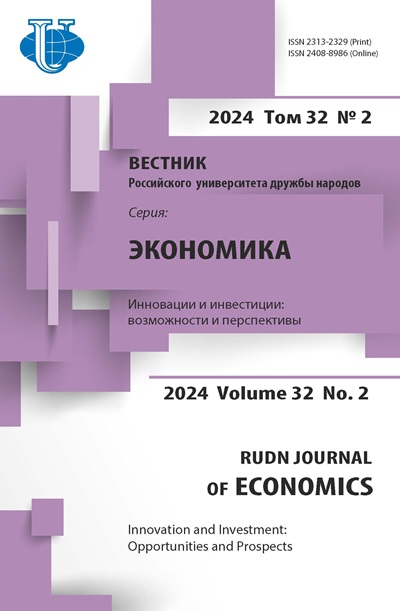Features of Digital Ecosystem Management at the Stages of Their Life Cycle
- Authors: Lebedeva D.V.1, Bondarchuk N.V.2, Ziroyan M.A.2
-
Affiliations:
- RUDN University
- Gubkin Russian State University of Oil and Gas
- Issue: Vol 32, No 2 (2024): INNOVATION AND INVESTMENT: OPPORTUNITIES AND PROSPECTS
- Pages: 324-336
- Section: INDUSTRIAL ORGANIZATION MARKETS
- URL: https://journals.rudn.ru/economics/article/view/39879
- DOI: https://doi.org/10.22363/2313-2329-2024-32-2-324-336
- EDN: https://elibrary.ru/ICNMDC
Cite item
Full Text
Abstract
The emergence and active development of digital ecosystems defines a new object of management study, integrating knowledge management, innovation management, operations management, supply chain management and organizational change. In conditions of competition and market barriers, economic entities actively use digital ecosystems as a key success factor. Digital ecosystems themselves are a special, complex management object whose properties change as they go through various stages of their life cycle. At the same time, the life cycles of digital ecosystems are influenced by the objects and subjects functioning in their contour and the economic systems associated with them. Based on the observation of economic systems and the influence of various factors on them, the authors determined the stages of the life cycle of digital ecosystems. Based on the study of the specifics of the behavior of digital ecosystems at the stages of their life cycles, the authors made conclusions about the most significant features of their management.
About the authors
Daria V. Lebedeva
RUDN University
Author for correspondence.
Email: lena_leb-61@mail.ru
ORCID iD: 0000-0003-4555-5707
Candidate of Economic Sciences, Associate Professor of Finance and Credit Department
6 Miklukho-Maklaya St, Moscow, 117198, Russian FederationNatalia V. Bondarchuk
Gubkin Russian State University of Oil and Gas
Email: n.bondarchuk2014@yandex.ru
ORCID iD: 0000-0002-8496-0652
Doctor of Economics, Professor, Professor of the Department of Digital Economy Security and Risk Management
65 Leninsky Avenue, Moscow, 119991, Russian FederationManya A. Ziroyan
Gubkin Russian State University of Oil and Gas
Email: zirmanya@mail.ru
Doctor of Economics, Professor, Head of the Department of Mathematical Methods for Ensuring the Safety of Systems 65 Leninsky Avenue, Moscow, 119991, Russian Federation
References
- Adizes, I. (2014). Corporate life cycle management. Trans. from English. Moscow: Mann, Ivanov and Ferber. 512 p. (In Russ.).
- Berg, D.B., & Goldstein, S.L. (2002). The specifics of the life cycle. In A.F. Shorikov (Ed.), Mathematical models in economics: inter-university collection of scientific tr. (pp. 64–71). Yekaterinburg. (In Russ.).
- Boyko, V.P., & Falko, S.G. (2020). Methods of measuring the effects of innovation activity by phases of the innovation life cycle. Issues of innovative economy, 10(3), 1101–1110. (In Russ.).
- Buratti, M., Cantner, U., Cunningham, J.A., Lehmann, E.E., & Menter, M. (2023). The dynamics of entrepreneurial ecosystems: an empirical investigation. R&D Management, 53, 656–674. (In Russ.).
- Cantner, U., Cunningham, J., Lehmann, E. & Menter, M. (2021). Entrepreneurial ecosystems: a dynamic lifecycle model. Small Business Economics, 57(4), 407–423. (In Russ.).
- Greiner L.E. (1998). Evolution and revolution as organizations grow. Harvard Business Review, May — June, 1–12. (In Russ.).
- Henderson, Bruce D. (2008). Product portfolio. BCG Review: digest. Moscow: Boston Consulting Group, 2, 7–8. (In Russ.).
- Kotler, F. (1991). Fundamentals of marketing (p. 180). Moscow. (In Russ.).
- Quinn, R.E., & Cameron, K. (1983) Organizational Life Cycles and Shifting Criteria of Effectiveness: Some Preliminary. Management Science, 29(1), 33–51. (In Russ.).
- Royce, W.W. (1970). Managing the development of large software systems Dr. Winston W. Rovce introduction. Ieee Wescon, 328–338. (In Russ.).
- Slavyanov, A.S. (2018). Approaches to the analysis of the patterns of development of mesoeconomical systems based on the life cycle. In G.B. Kleiner (Ed.), Strategic planning and development of enterprises. Materials of the Nineteenth All-Russian Symposium, 661–663. (In Russ.).
- Vernon, R. (1966). International investment and international trade in the product cycle. The Quarterly Journal of Economics, 80(2), 190–207. (In Russ.).















